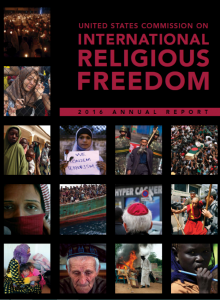Two reports released in May condemn the persecution of Tibetan religious freedom.
 The United States Commission on International Religious Freedom’s (USCIRF) annual report found “extreme surveillance and strict monitoring” within Tibetan monasteries.
The United States Commission on International Religious Freedom’s (USCIRF) annual report found “extreme surveillance and strict monitoring” within Tibetan monasteries.
Amongst the abuses listed by the USCIRF are violent crackdowns on Tibetan Buddhists and their rights; religious harassment; harsh policies and imprisonment. Also highlighted is government “targeting of human rights lawyers and dissidents who advocate for religious freedom”.
The report was released shortly after the US State Department re-designated China as a “Country of Particular Concern” (CPC) with regards to its tolerance of “particularly severe” religious freedom abuses. China has held this status since the inception of the CPC mechanism in 1999.
International criticism, protests and 143 self-immolations within Tibet since 2009 have been answered with increased religious persecution. USCIRF states that “over the past year, the Chinese government has stepped up its persecution of religious groups deemed a threat to the state’s supremacy and maintenance of a ‘socialist society’”.
A separate report by the London-based Tibet Watch, correlates activities of religious institutes with crackdowns on religious freedom. Religious freedom has faced attack since the Cultural Revolution, when private religious practise became illegal.
 Tibet Watch lists assorted government responses to religious dissent, including the “imposition of ‘work teams’, surveillance cameras within monasteries, dedicated police stations, frequent inspections, and numerous arbitrary regulations.”
Tibet Watch lists assorted government responses to religious dissent, including the “imposition of ‘work teams’, surveillance cameras within monasteries, dedicated police stations, frequent inspections, and numerous arbitrary regulations.”
A pattern of uprisings and reprisals can be traced from 1987, when 21 Drepung monks demonstrated on the streets in Lhasa, igniting widespread protests and leading to the introduction of martial law.
Following the arrest and disappearance of the Panchen Lama in 1995, a new set of strict regulations was imposed on monasteries, including enrolment limitations.
Further interferences included the introduction of a “patriotic re-education” programme, which forced monks to denounce His Holiness the Dalai Lama, and a database of official Rinpoches, which lists reincarnated lamas who are approved by the central government.
As well as being a focal point for protests, monasteries are important to Tibet’s digital resistance given their strong contact network, ensuring news from inside Tibet reaches the outside world.




 Print
Print Email
Email